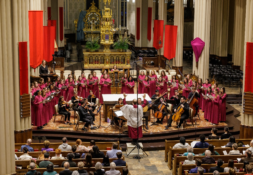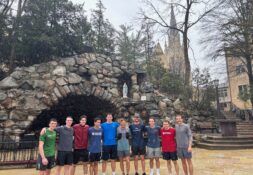Reflecting on the timeless tunes of the Emerald Isle
What did you think of when you first heard the name Irish Rover? Perhaps you don’t have a clear recollection. For a select few, the name brings back memories of youthful song and dance, and a little tune that goes:
We’d an elegant craft, it was rigged for and aft
And how the wild winds drove her
She had twenty-three masts and she stood several blasts
And they called her the Irish Rover.
This publication is just another example of how Irish music found its way into an already-colorful campus culture. Whether it’s dancing to “Rakes of Mallow” in Notre Dame stadium, or singing “The Wild Rover” as the Irish tally another win, students join in together regardless of whether or not they have Irish heritage. What is it about this genre that is so timeless? Music that is so simple, yet has captivated audiences for centuries; music that has inspired many popular artists, including Bono, Van Morrison, Ed Sheeran, and Bob Dylan. What makes Irish folk music so special? Is it the use of classic instruments, such as the harp, banjo, and tin-whistle? Or perhaps the catchiness of the tune?
More than anything else, the music conjures up an intimate sense of place. Whether the recording is from days of old—such as the Clancy Brothers’ 1966 album Isn’t it Grand Boys—or new, like the High Kings’ 2010 album, Memory Lane, the music permeates throughout your body, transporting you to an Irish living room or the backroom of a pub. Perhaps this is because a large number of these albums, including Seamus Kennedy’s By Popular Demand, were in fact recorded in such places. In no other genre will you take such great joy out of live recordings, and savor every sneeze, cough, and chuckle from the audience.
This setting not only creates a feeling of authenticity with every crackle of the recording; it also allows performers to recount Irish history or to provide context to their songs. In a 1984 concert, prior to playing the Irish street-ballad, “Finnegans Wake,” which inspired author James Joyce’s novel by the same name, Liam Clancy of the famed Irish folk group ‘The Clancy Brothers,’ remarks:
“James Joyce—the author—was fascinated by this song. Most of us thought it was another drinking song … the fella dies, is laid out, whiskey spills on him (the water of life) and needless to say, he rises from the dead. What else would he do? [laughter]. Right, the rest of us saw it as a funny little song, fun at a party. Joyce saw in it the entire cycle of life, death, and resurrection of the whole universe.”
As Joyce understood, Irish folk music transcends the understandable vanity of musical pleasure and entertainment to speak to what it means to be human. While produced in an intimate setting, these songs encapsulate the intimate emotions of real people and real stories. Behind every song is a story; a story of love, heartbreak, bravery, virtue, or regret. “The Whistling Gypsy,” tells the story of a young woman who falls in love with a man who appears to be a lowly gypsy, much to her father’s chagrin. As the song progresses, the listener discovers that this ‘gypsy’ is actually a nobleman, exposing her father’s avariciousness in the midst of true love.
Another popular song, “Brennan on the Moor,” describes the tale of Irish highwayman Willy Brennan who robs the mayor of a local town and flees to nearby mountains. Brennan initially escapes the authorities, but is subsequently turned in by his lover for a one-hundred pound reward. The ballad closes with the highwayman’s capture, reminding the audience to be wary of the intentions of those they hold close.
The afflictions of the Irish people serve as a frequent inspiration for folk music. The music, in telling the stories of brave freedom fighters, inspires and unites the Irish people. Many of the most popular Irish folk songs recount stories from the 1798 Irish rebellion, and in almost every case depict Irish freedom fighters. “Kelly, the Boy From Killane,” “General Monroe,” and “Roddy McClorely” all tell the story of rebellion leaders. One of the most famous, entitled “Boolavogue,” tells the story of Irish Catholic priest Father John Murphy, who led rebels to victory in Wexford. The song recalls:
Then Father Murphy, from old Kilcormack,
Spurred up the rocks with a warning cry;
“Arm! Arm!” he cried, “For I’ve come to lead you,
For Ireland’s freedom we fight or die.
Of course, Father Murphy was eventually defeated. The British soldiers proceeded to strip, flog, and hang him, after which he was decapitated, burnt in a barrel, and his head impaled on a pike. The end of the song does not concede defeat, however, as is common in most of these ‘rebel songs:’
God grant you glory, brave Father Murphy
And open heaven to all your men;
The cause that called you may call tomorrow
In another fight for the Green again.
Almost all of these songs convey a sense of hope in the face of struggle, uniting its listeners and contributing to a national identity rooted in culture and family. Today, American folk music is a source of debate and division. While Irish folk music has been a unifying force for the Irish, American folk music seems to only divide Americans by race and political ideology. The music of American folk legend Pete Seeger is too ‘communist,’ for some, and a good number of well-known American folk songs such as “Oh! Susanna” are rooted in the racism of blackface minstrel songs. Irish folk music, however, has stood the test of time, and can serve as an antidote to an American music culture obsessed with shock value, ideology, and entertainment. In a culture of division, the intimate and unifying songs of the emerald isle can serve as poignant inspiration for American culture.
Photo credit: Irish Folk session, The Old Dubliner Irish Pub, Hamburg-Harburg, licensed under Creative Commons CC BY-SA 3.0 license





